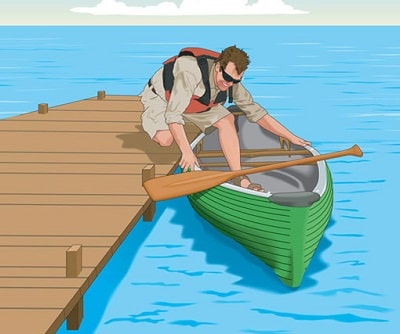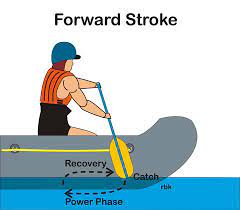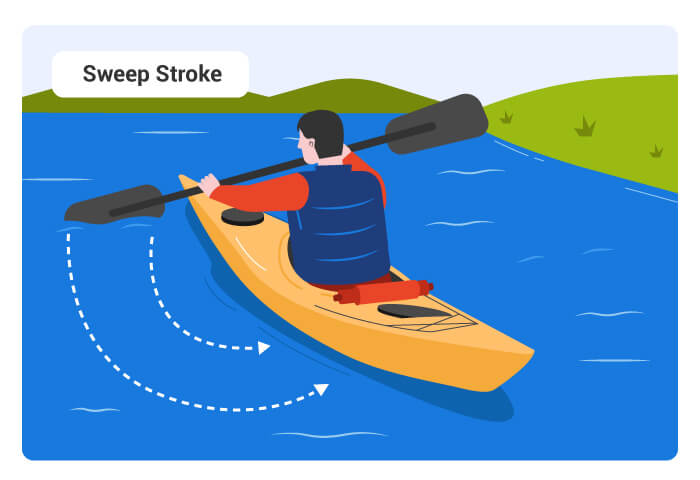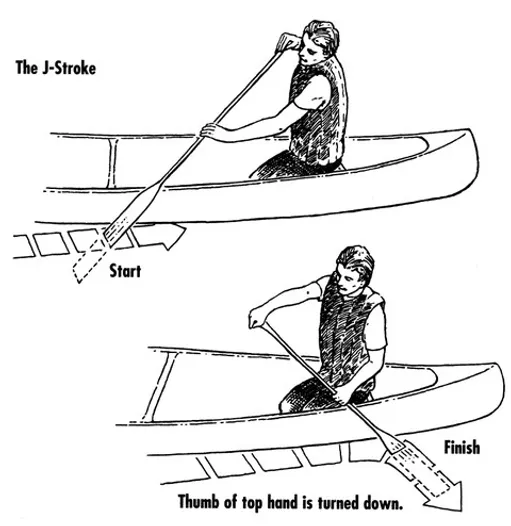Are you ready to embark on a canoeing adventure but feeling a bit uncertain about steering? You’re not alone. Knowing how to steer a canoe is a fundamental skill that every paddler should possess.
Besides the right technique, you should also know who steers in a canoe. Basically, two paddlers (stern and bow) take this responsibility on their shoulders.
In this blog post, we will explore the art of canoe steering and provide you with essential tips and techniques to navigate with confidence.
Whether you’re a seasoned paddler or just starting out, understanding the dynamics of steering and the roles of each paddler will set you on the path to mastering this essential skill.
So, let’s dive in and discover the secrets to successful
How to Steer a Canoe – Explained in Steps
Steering a canoe requires a combination of proper technique, balance, and following the right steps as explained below:
1. Position for Balance
Sit in the center of the canoe to distribute your weight evenly. Keep your feet and knees slightly bent and your body relaxed. This helps maintain stability and balance.
If you’re beginner and a bit skeptical about the canoeing stability then you can also DIY canoe stabilizers to give your boat much stability in the water.
2. Getting into Canoeing
Start by finding a local canoeing club or instructor who can provide lessons. They will teach you essential skills, and safety measures, and help you become familiar with the equipment.

3. Proper Grip on the Paddle
Hold the canoe paddle with both hands, about shoulder-width apart. Your top hand should grip the paddle near the top, while the lower hand should grip it lower down, with both hands facing outward. This grip allows for better control and maneuverability.

4. Forward Stroke for Straight Movement
Dip the paddle blade fully into the water near the front of the canoe. Push the paddle backward while keeping your arms straight, using your torso and core muscles to generate power.

As you reach your hip, lift the paddle out of the water and repeat on the other side. This stroke propels the canoe forward in a straight line.
5. Sweep Stroke for Left Turn
To turn left, position the paddle in the water near the bow (front) of the canoe. And then push the paddle away from the boat in a wide arc, creating a sweeping motion. This stroke generates momentum that turns the canoe to the left.
6. Sweep Stroke for Right Turn
To turn right, perform the same sweep stroke but on the opposite side of the canoe. Position the paddle in the water near the bow (front) on the right side and sweep it away from the boat in a wide arc. This stroke turns the canoe to the right.

7. J-Stroke for Fine-Tuning
The J-stroke is used to correct the canoe’s direction while maintaining forward momentum. Start with a regular forward stroke, but as the paddle reaches your hip, rotate your top hand inward, causing the paddle blade to slice outward in a J-shape. This slight correction prevents the canoe from veering off course.

8. Communication with Canoe Partner
Effective communication with your canoe partner is essential for coordinated steering. Use verbal signals or agreed-upon paddle gestures to indicate your intentions and coordinate your strokes.
If you’re canoeing with your family, then stability should be your first concern and therefore, you need wider canoes, but remember, maneuverability of wider canoes is not that great. Therefore, opt for best canoe for family which has good width, but also good in steering.
9. Practice in Different Water Conditions
Practice canoeing in various water conditions such as calm lakes, slow-moving rivers, or even slightly choppy waters like whitewater canoeing. This experience will help you adapt your steering technique to different environments and improve your overall skills.
10. Experiment with Braking
To slow down or stop the canoe, use a reverse stroke by pulling the paddle towards the bow instead of pushing it away. This action creates resistance in the water, helping you decelerate or come to a complete stop.
11. Avoiding Fatigue
Canoeing can be physically demanding, especially on longer trips. To avoid fatigue, focus on maintaining a relaxed posture, use your core muscles for power, and take short breaks when needed. Building up your strength and endurance over time will also help prevent exhaustion.
Between, bent shaft and straight shaft canoe paddle, it is recommended to go with later on as it is preffered for steering, especially if you’re beginner.
Tips for Beginners
If you are a beginner to this sport, following the below tips on how to steer a canoe can help a lot.
1. Choose Calm Water for Practice
When starting out, select calm and flat water conditions for practice sessions. This could be a lake or a slow-moving river with minimal currents. It provides a controlled environment where you can focus on mastering basic techniques without the added challenges of strong currents or waves.
A shorter canoe paddle length offers good control over the vessel as compare to the longer paddle, similarly, narrower canoe paddles also favorable for better steering.
2. Be Aware of Surroundings and Avoid Obstacles
Always be mindful of your surroundings while canoeing. Keep an eye out for rocks, submerged logs, overhanging branches, and other obstacles that could potentially disrupt your paddling or pose a safety risk.
3. Communicate with Your Paddling Partner
Clear and effective communication with your paddling partner is crucial. Establish signals or paddle gestures to indicate your intentions, such as signaling for a turn or to stop.
This helps maintain coordination and prevents any misunderstandings or accidents while maneuvering the canoe.
4. Start with Basic Paddling Techniques and Maneuvers
Begin with the fundamental paddling techniques mentioned earlier, such as the forward stroke, sweep strokes for turning, and the J-stroke for fine-tuning. Mastering these basic techniques will provide a solid foundation for more advanced maneuvers as you progress in your canoeing skills.
Steering wise, narrow canoes are better as compared to the wider canoe, though it lacks in stability.
5. Focus on Maintaining Proper Posture and Balance in the Canoe
Good posture and balance are essential for stability and efficient paddling. Sit upright with a straight back, and avoid leaning too far to one side. Distribute your weight evenly in the canoe, keeping your center of gravity low. This helps maintain stability and prevents the canoe from tipping over, however canoes doesn’t tip over easily. Most importantly, a paddler should be aware of how to right a capsized canoe to be prepared for such emergency situation.
6. Gradually Increase the Difficulty of Paddling Conditions as Skills Improve
As you gain confidence and proficiency, gradually introduce more challenging paddling conditions. Start by exploring slightly faster-moving rivers or lakes with gentle currents. This progressive approach allows you to adapt to changing conditions while building your skills and experience.
Remember, canoeing is a skill that develops over time through practice and experience. Don’t be discouraged by initial challenges or mistakes. With patience, perseverance, and a commitment to learning, you’ll become a competent and confident canoeist.
What is Stern Paddler Bow Paddler at the canoe and what they do?
In a canoe, the stern paddler and the bow paddler are the individuals who occupy the respective positions at the back (stern) and front (bow) of the canoe. Each paddler plays a crucial role in maneuvering and controlling the canoe effectively. Here’s a breakdown of their responsibilities:
1. Stern Paddler
The stern paddler is typically positioned at the back of the canoe, closest to the stern. They are often considered the “captain” or “steersperson” of the canoe. The stern paddler has several important tasks, including:
Steering: The stern paddler is responsible for steering the canoe. By using their paddle as a rudder, they can control the direction and ensure that the canoe moves smoothly.
Power and Momentum: The stern paddler also provides power and momentum to the canoe. They use their paddle to propel the canoe forward by engaging in a strong paddling technique, setting the pace, and maintaining a steady rhythm.
2. Bow Paddler
The bow paddler sits at the front of the canoe, closest to the bow. While their role is primarily to assist the stern paddler, they have specific responsibilities as well:
Power and Speed: The bow paddler contributes to the forward momentum by paddling with strength and efficiency. They work in sync with the stern paddler, ensuring a balanced and synchronized paddling rhythm for optimal speed and efficiency.
If you’re not satisfied with current speed of your canoe, and want to speed up your canoe then you can mount an outboard motor for canoe for relaxing your muscles and obviously, for much-needed speed.
Balancing and Stability: The bow paddler helps maintain the balance and stability of the canoe. By shifting their weight or adjusting their position, they can counterbalance any movements or weight shifts that occur during paddling, especially in rough waters. Also, if you ask me which is one part of a canoe which contributes the most to vessel stability then certainly, it’s the bow’s design.
Obstacle Spotting: Positioned at the front, the bow paddler has a better view of the water immediately in front of the canoe. They assist the stern paddler by keeping an eye out for obstacles, rocks, or other potential hazards and communicating these to the stern paddler for appropriate navigation.
Both the stern and bow paddlers need to work together in harmony, communicating effectively and coordinating their movements. This is important to ensure efficient paddling, maneuverability, and a safe canoeing experience.
Which is the Most Stable Position for Canoe Paddlers?
In terms of stability, the most stable position for canoe paddlers depends on various factors, including the design of the canoe, the water conditions, and the skill level of the paddlers. Generally, there are two common positions that offer good stability:
1. Sit-on-Top
This position involves sitting on top of the canoe, with your legs positioned inside the canoe. This configuration lowers the center of gravity and provides a stable base.
It is often used in recreational canoes or when paddling in calm or slow-moving waters.
2. Kneeling
Kneeling in the canoe provides a lower center of gravity, enhancing stability. This position is commonly used in traditional canoes or canoes designed for whitewater paddling.
By distributing your weight between your knees and shins, you can maintain better balance and control in rougher water conditions.
Also, you should know that the stability of a canoe is influenced not only by the position of the paddlers but also by factors such as the width and depth of the canoe, its hull design, and the distribution of weight and gear within the canoe.
Additionally, the skill and experience of the paddlers in maintaining balance and executing proper paddling techniques also contribute to stability.
Steering a Canoe, kayak, or Pedal Boat – Which is easy?
Steering a kayak is generally the easiest, as they are designed for responsiveness and can be controlled with paddle strokes.
On the other hand, canoes require practice and coordination, using the paddle as a rudder. This might be a little complicated for beginners to understand.
Finally, steering a pedal boat is straightforward, similar to riding a bicycle. However, practice and experience are a must for riding all watercraft.
Do you know that you can also use kayak paddle for canoe, as double blade paddles makes steering/maneuverability much easier, and gives you more control even in narrow paths.
How do I Deal with Wind and Currents while canoeing?
Dealing with wind and currents while canoeing can be challenging, but with the right techniques and strategies, you can navigate through them effectively. Here are some tips to help you deal with wind and currents while canoeing:
1. Plan your Route
Before heading out, research and plan your route considering wind and current conditions. Choose sheltered areas or plan your trip with the wind or current in your favor whenever possible. And Don’t forget to bring Map And Compass/GPS during the journey.
2. Paddle into the Wind or Current
If you need to paddle against the wind or current, maintain a steady pace and do so with power and efficiency. Use a combination of strong forward strokes, angling your paddle slightly into the wind or current, and maintain a steady rhythm to make progress.
3. Utilize a Ferrying Technique
If the wind or current is strong and directly against you, consider using a ferrying technique. Paddle diagonally across the wind or current at an angle, alternating sides to maintain a gradual sideways movement towards your destination.
This technique can be useful for conserving energy and making progress while minimizing the effects of the wind or current.
4. Adjust your Trim and Weight Distribution
If you’re experiencing strong winds, adjusting the trim of your canoe can improve stability. Move gear or shift your weight forward or backward to find the optimal balance and minimize the effect of wind pushing against the side of the canoe.
5. Stay Low and Reduce Wind Resistance
When paddling in windy conditions, keep a low profile by crouching or kneeling in the canoe. This reduces wind resistance and helps maintain stability.
6. Be Cautious and Consider the Safety
In strong winds or currents, always prioritize safety. Assess your skill level and the conditions before deciding to continue or seek shelter. Wear appropriate safety gear, such as canoeing life jackets, and be prepared for unexpected changes in weather or water conditions.
Conclusion
Here you have it: the How to Steer a Canoe guide.
To steer a canoe effectively, practice and master techniques such as using the paddle as a rudder, maintaining synchronization between paddlers and employing maneuvers like the J-stroke or sweep stroke.
Consider factors like wind and currents, adjust weight distribution for stability, and prioritize safety. With experience and skill, you can confidently navigate and enjoy your canoeing adventures.
FAQs
What is sculling and what does it do?
Sculling is a paddle technique where the paddle is used in a horizontal motion to create a swirling or sculling effect in the water. It is primarily used for stability, maneuvering, and turning the canoe.
How do I master paddle strokes?
To master paddle strokes, practice proper body positioning, grip, and paddle placement. Focus on technique, use torso rotation, and practice different strokes, such as forward, reverse, draw, and sweep strokes, in various conditions to build proficiency.
Which paddling technique is best for canoeing?
The J-stroke is a commonly used paddling technique in canoeing. It combines a forward stroke with a slight correction at the end to prevent the canoe from veering off course. It provides good forward propulsion and helps with maintaining a straight line.
How can we improve synchronization between paddlers?
To improve synchronization between paddlers, communicate and establish a paddling rhythm, practice together, and focus on coordination. Pay attention to timing, stroke placement, and maintaining consistent paddle cadence.
What is a sweep stroke?
A sweep stroke is a wide arcing stroke that starts at the bow or stern and sweeps the paddle blade in a wide arc away from the canoe. It is used for turning the canoe quickly and effectively.
What is the purpose of the rudder in canoe steering?
Some people thought canoeing is dangerous, which is not true at all. Most importantly, rudder in canoe improves the maneuverability and maintain straight tracking. It is typically controlled by foot pedals, allowing the paddler to adjust the rudder’s position in the water, especially in kayaks and some specialized canoes.
Does the force use while paddling affects the speed of the turn?
Yes, the force used while paddling can affect the speed of the turn. Applying more force during a turn can increase the canoeing speed of the turn while reducing force can result in a slower turn. Additionally, the angle and technique used during the turn also influence its speed and effectiveness.

Jack Bennett, a passionate pedal boating enthusiast, and marine engineer by day, is here to share my knowledge and love for this exciting sport with you all. Happy Boating!
